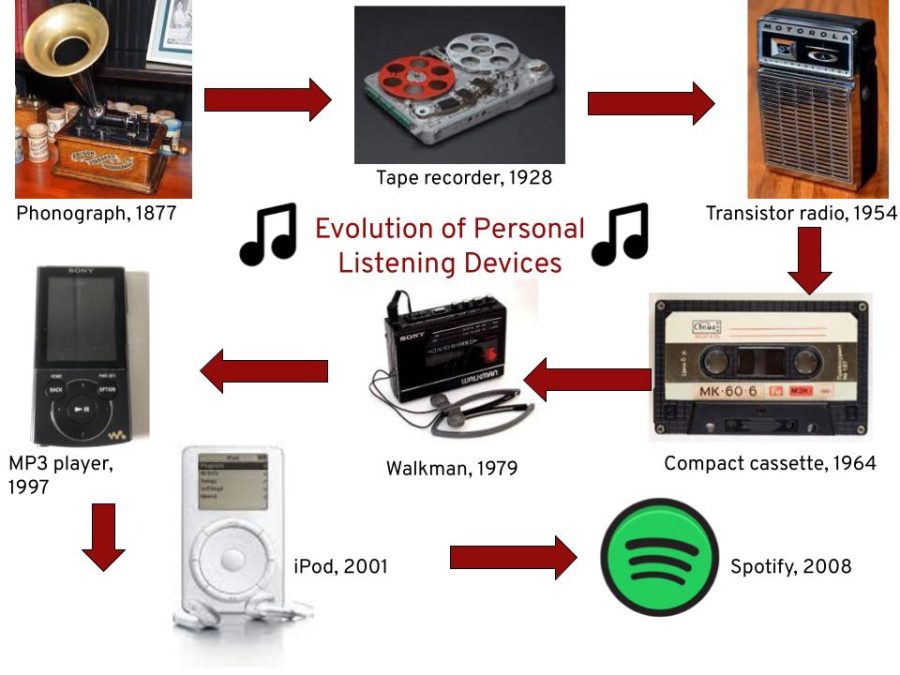From pop to punk: perfecting the playlist game
Personal listening devices have come a long way since the phonograph, or gramophone, of the late-19th and early-20th centuries. Developments have skyrocketed since the advent of the Digital Age, bringing countless new artists to the masses through digital streaming. Today, listeners can find songs by searching a title or lyric on the internet or a streaming service.
It’s happened to the best of us; you’re carpooling with your friends and someone passes you the aux cord. Panicked by this sudden increase in road trip responsibility, you shuffle to the first playlist you see and suddenly Lewis Capaldi is crooning through the speakers as your friends side-eye you because you just turned on Spotify’s “Lonely Sad Mix.” Way to kill both the mood and your aux privileges.
But what if you could have avoided the entire debacle with a curated playlist of your own? It’s actually pretty simple; follow the guide below to create the perfect playlists for every occasion, and you’ll never never have to worry about a carpool playlist panic again.
Tip 0: A brief history of the playlist
Before we dive into the dos and do-nots of playlist curation, it’s important to understand where playlists come from and why they have become so central to social culture.
Music has been an integral part of society for millenia, and people have been compiling lists of their favorite songs for as long as the technology has existed to play them.
Radios and phonographs in the late 19th and early 20th centuries first brought recorded music to the masses. Radio programs led to the coinage of the term “disc jockey,” later abbreviated to “DJ,” in the 1930s to describe someone who plays recorded music for an audience. Following the advent of mass-produced cassette tapes a few decades later, the general population gained the ability to create their own mixtapes.
The idea of having one’s favorite songs in one location has been refined as the playback technology to listen to those songs has evolved. From 8-track tapes to CDs to Apple’s iPod Shuffle, personal music-listening devices became increasingly tied to social culture as developments in digital technology allowed people to more easily curate lists of music for any occasion or preference they desired.
With thousands, or even millions, of songs available at a user’s fingertips thanks to digital streaming services, playlists are easier to create than ever. They keep listeners in the loop of the most popular music and expose them to new artists and sub-genres. The sheer ability to listen to everything from Vivaldi to Vanilla Ice all on the same playlist has allowed listeners tastes to become as hyper-specific as their circumstantial playlists.
Tip 1: Do pick songs you actually like
Though it may seem no-brainer, the first step in creating the perfect song list is to only choose songs that you actually want to listen to. This guarantees investment in the music and prevents mixes from becoming selectively forgotten.
Mrs. Merich, who creates a playlist based off student recommendations for each of her classes, said, “The playlists update a little throughout the year, but they don’t change too much. It’s kind of fun because, at the end of the year, students will hear a
song they liked at the beginning of the year and be reminded of it.”
Merich also noted that students tend to tire of the songs that are most popular at the start of the school year. The most popular songs at the beginning end up being the ones students ask to skip later on.
Tip 2: Don’t have an vibe or artist imbalance
Creating a playlist is all about matching music to feelings in a certain moment. That said, keep playlists focused and don’t let them become master list catch-alls of every song you’ve ever liked.
“You can’t have a million songs from one band. [The playlist] becomes cluttered and without variation. But mixing too much creates an issue too. You probably don’t want both alt music and hip hop [on the same list],” warned Senior Aiden McCoy.
Relying too heavily on a certain artist may cause one to overplay their music and become uninterested in the playlist. Hyper-focused song lists also prevent discovery of up-and-coming artists or niche subgenres.
Tip 3: Do create situational playlists
Don’t be afraid to have several highly-specific and varied playlists. The songs that increase focus while studying are certainly different from the music played at a party with friends or the tracks one sobs to after a tough breakup. Music is deeply rooted in emotions, but its also a form of story telling. That’s why it makes sense that different songs fit different moments in life and that a good soundtrack can make any experience more memorable.
Tip 4: Don’t “set it and forget it”
Last but not least, don’t forget to update your playlists. Music tastes may change over time, so it’s perfectly acceptable, even encouraged, to switch it up now and again. Not changing up playlists means one will likely grow tired of them and miss out on the opportunity to add newly released songs or discover new artists.
“I usually use a ten-second rule [for making playlists],” said Senior Siddaly Brooks, “I’ll listen to a song for ten seconds and then if I don’t want to listen to it any more, I’ll take it off the list.”
Brooks’ advice keeps her playlists fresh and ensures she’s never stuck reshuffling or hitting skip again and again.
Though it may seem complicated at first, creating playlists is actually a great way find new favorites or discover a new music interest. By curating varied, purposeful playlists and updating them annually, you’ll always have the perfect tunes queued up, be it for studying, hanging out or the (no-longer) dreaded carpool aux scene.
Outside of school, you can usually find Emma dancing, solving word puzzles, buried deep inside a book, or dreaming of some new and delicious dessert to...





